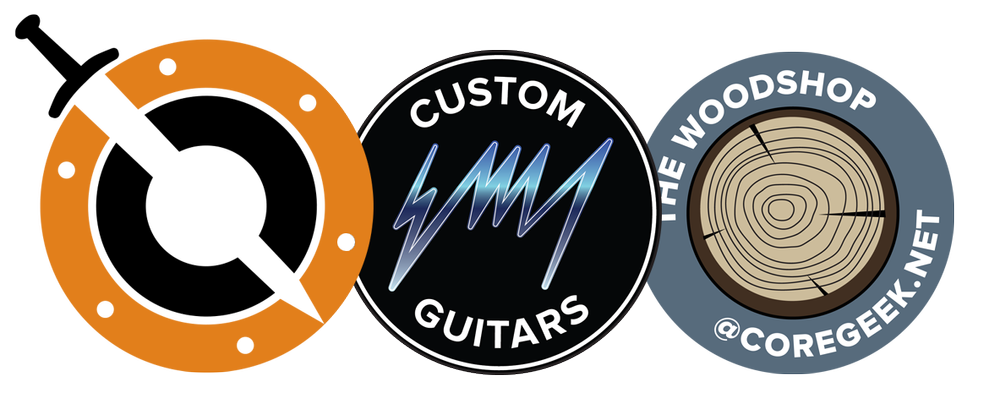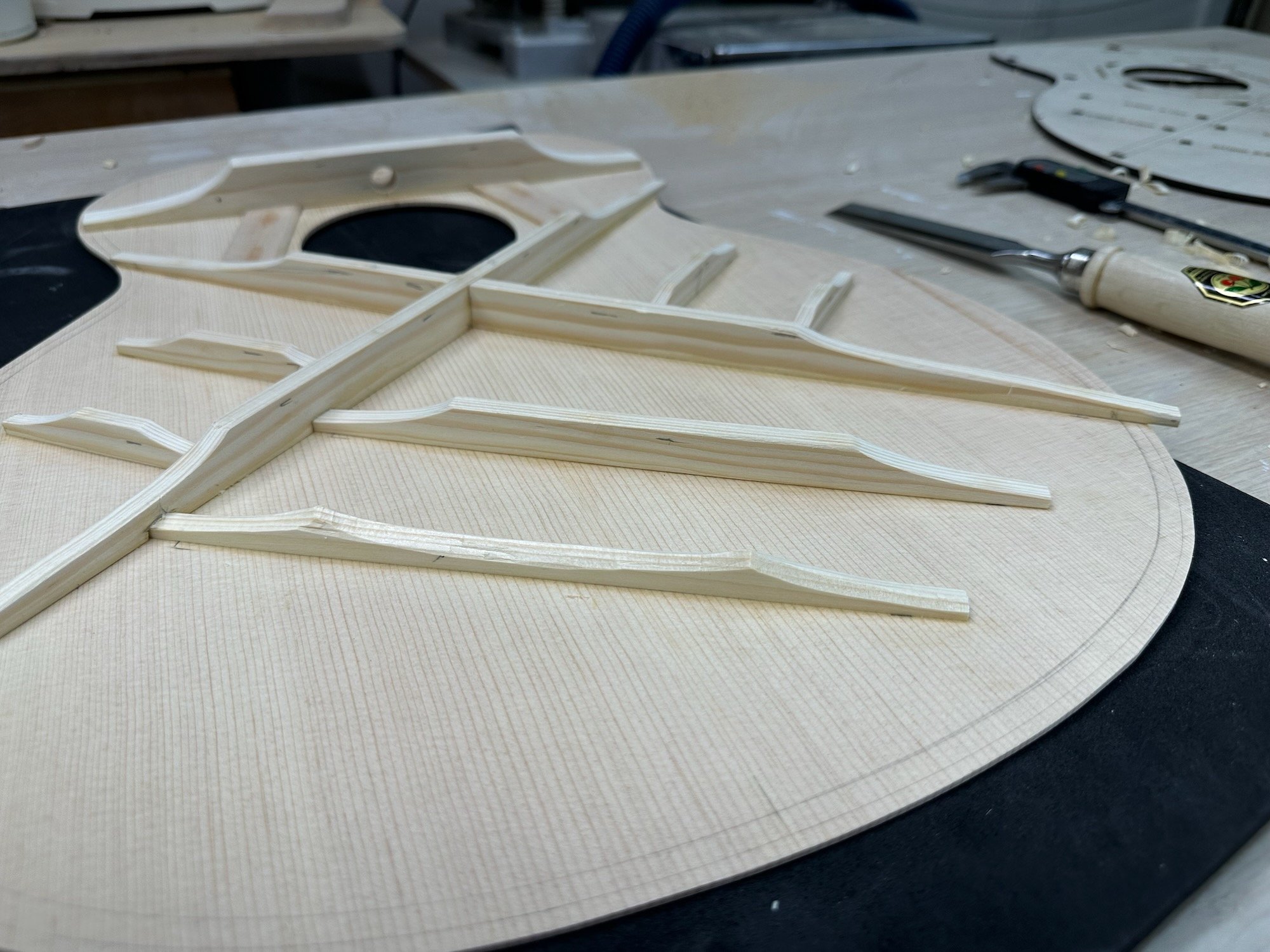Wood Selection
Before I get into the build details, I’d like to talk a little about my wood selection for this project. The most typical woods used for acoustics are Spruce for the top and Mahogany for the sides. Although those are the most common, just about any type of wood can be used. Like all things specialty, hardwoods can get quite expensive (high end Koa and Rosewood side and back sets can cost anywhere from $500 and up). I wanted to keep the costs as low as possible so I kept an eye out for medium grade woods that would not be terribly expensive. I also wanted to use quality woods even if they were not of the highest grade. The higher grade mostly has more to do with aesthetics (although some more desirable grain patterns can make a structural difference).
A few years ago, I got some great deals from my favorite hardwood supplier Kimball Hardwoods. I bought two Birdseye Maple body sets for $100 and a Sitka Spruce Top set for $50. They have been sitting and waiting in my wood library ever since. I am aware that most guitar building guides will dissuade you from using both Maple and figure woods for a guitar body. Both are considered more difficult to work with. Some builders/players also say a Maple body has less resonate, less deep sound compared to the darker hardwoods. I happen to love Maple and well a good deal is a good deal. Also, I was keen on the thought of having a couple of inexpensive sets to practice with for my first build. The neck will be made from Walnut. I have some Walnut in my wood library that I received for free and it just makes sense to use it. Plus, I think the contrast of a maple body and walnut neck will look sharp. I haven’t decided on the fretboard material yet. I have Ebony, Claro Walnut, Maple, Rosewood, Padauk and a couple others I’m probably forgetting all on hand. So I have some options and will eventually decide what combo looks best with the body and neck. I’m planning to use Walnut from the neck plank as the body binding, if I can make it work. I’ve done very little wood bending prior to this project.
If I haven’t mentioned it already, I’m not expecting this first guitar to be amazing. I see it as a test of the process of which I expect to encounter many mistakes. If I can get a reasonably good looking, sounding and playing instrument out of it, I’ll be happy. In short: good but not great, is my minimum goal.
Soundboard and Back Glue Up
I started the build by joining the top and back parts. I don’t have a jointer, so I cleaned up the center joint with a table saw trick I saw online. Unfortunately, I lost the link to the video. Basically you place the two halves together the way they will be glued. Temporarily hold them together by spanning a couple of scrap pieces of wood with double stick tape. Then set the cut to be dead center of the joint, and rip it down the center. Then glue up. It work quite well. After the glue joint dried I ran both planks through my drum sander. I sanded the back to an initial thickness of 3.5mm, with an eventual final thickness of 2.5mm. I sanded the front to an initial thickness of 3.5mm, with an eventual final thickness of 3mm. The photos are after glue up.
Disclaimer: Sometimes I get too focused in the shop and forget to take photos. I apologize that there will be steps along the way that have no photos.
The Rosette
I contemplated what the rosette design would be for quite a while. Ultimately I decided on a somewhat simple pattern utilizing two different wood species, Walnut and Roasted Maple as well as 1mm black veneer I had on hand. After laying out the pattern in Adobe Illustrator I imported the design into the laser cutting software (LightBurn) and cut a test to figure out the spacing and tolerances (#1). After tweaking some of the sizes I then laser cut the pattern out of the actual woods and painstakingly glued it all together (#2). This worked okay but without any backing, the pieces were difficult to keep together. I then realized if I taped at all together first from the back, I could dry-fit the pieces and easily add glue between the pieces (#3). Once that was done (#4) I taped it down to a flat board and ran it through the drum sander to level all of the pieces the same thickness (#5). I kept the final size around 3mm thick so It could be embedded proud of the soundboard then sanded down to match the final thickness of the soundboard at the same time. Finally, I finished up the final sizing by laser cutting the edges (#6). You will notice I also laser etched some added detail lines. Unfortunately I did not etch the lines deep enough and the lines were removed when I completed the final thickness sanding of the soundboard.
My next step was to inlay the completed rosette on the soundboard. I utilized my plunge router along with a circle jig and a straight 1/4” bit to make the circular dado for the inlay (#7). This process was pretty straight forward, if you’ve ever routed a circular dado. The hard part was figuring out the perfect size of the inside and outside of the rosette with the adjustable router jig. Not seen here are several waste boards I tested the sizing on. It took multiple minimal increment changes in order to get the sizing perfected so the two veneer strips and the rosette would fit snugly. Once I perfected the sizing it took 3-4 passes with the router to cut the full width of the dado. This photo shows one of those passes (#8). After I glued in the rosette using standard TiteBond, I ran the soundboard back through the drum sander using 220 grit paper and sanded it down to the final thickness (3mm).
Later, I discovered a spot where the edge of the rosette had a small gap. I repaired that gap by filling it with black Starbond CA glue and accelerator. I used frog tape to help keep the CA glue from staining the wood (#9, #10).
Once that was all cleaned up, I cut out the sound hole with the router and jig (#11, #12).
Bracing/Shaping the Soundboard and Back
Note: I made the Back/bracing prior to the Soundboard before I decided to blog this build. Consequently, I took very few photos of working on the Back. I’m writing more about the Soundboard but know the process for the Back is essentially the same. Also some of the photos will seem slightly out of order as I’m mixing the process together as I write about them.
The final step of the Soundboard involved making and placing the underside bracing. In order to place everything correctly I previously made a template based on the Kinkead design. I took a photo of the full sized printed plan that was included with the book, and sized it full scale in Adobe Illustrator. I then redrew the plan as a vector file and imported the design into Lightburn for laser cutting out of 1/4” plywood. All of the sizing for the bracing is marked on the template (#13).
The braces are made from Red Spruce I bought from American Tonewood. I cut the braces (end grain vertical) to size with an added 3-4 mm extra in height (#14). I rough cut the end curves with my bandsaw (no photo). The thin wide top strip bracing and blocks around the sound hole are offcuts from the top. The bridge brace is made from Walnut for extra strength.
When finished, the Soundboard and Back need to be slightly curved for rigidity. These curves are referred to as a Radius. The Soundboard will have a curve Radius of 25ft. the back Radius is 15ft. The concave radius dishes (I wrote about in Part 1) are utilized to achieve the Radius curves through shaping (sanding) and clamping (on the GoBar deck). Each of the Spruce braces have to be shaped to their respective radius curve. To accomplish this each dish is covered in sticky-back 80 grit sandpaper. The brace is then “sanded” back and forth on its back edge until the wood has been shaped into a matching curve (#15).
After all of the braces have been shaped they are glued to the Soundboard (or Back) while it is sitting on the radius dish. For clamping, the radius dish is placed on the bottom of the GoBar deck. The GoBar deck allows for clamping of multiple pieces on a curve. It applies pressure through the flexible struts onto the braces. That pressure pushes the Soundboard/Back into the radius shape. Once the glue has dried the Soundboard/Back retains the concave shaped of the dish (#16).
Note: Be aware of glue squeeze-out when clamping and be sure to have a cleanup solution at hand. For some of the pesky hard to reach joints, I used a utility knife blade to scrape off the wet unwanted glue.
Scalloping the Braces
After the braces are glued in place they need to be carved into their final shape (#17). I used both a mini-hand plane and chisels to create the scallop shapes. The Spruce is carved fairly easily but I highly recommend well sharpened chisels to keep the work as clean as possible.
The shaping part of the process apparently aids in the resonance and voicing of the Soundboard. At this point you can tap the board and hear the response as material is removed. The Kinkead book refers to “listening out for the dropping of pitch”. I think I heard it along the way. I’m not really sure though as I don’t have any experience to compare it to.
I was well underway with the scalloping when I realized I had forgotten to add a small ridge cap over the x-brace joint. Fortunately, I hadn’t fully carved that area yet so I was able to add the cap (#18.)
Once the carving was done I smoothed all of the braces out by sanding first with 80 grit paper I then finished with a pass of 120 grit and finished with 220 grit (#19., #20.)
That’s all for the Soundboard and Back. Next will be all about shaping the Sides.























